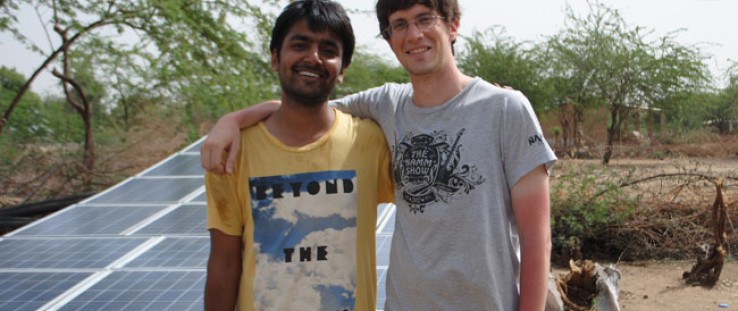 Yashraj Khaitan (left) and Jacob Dickinson, both founders of Gram Power, stand next to several solar panels in India. The panels are part of Gram Power’s central infrastructure being built in Indian villages for electrification.
Gram Power
Yashraj Khaitan (left) and Jacob Dickinson, both founders of Gram Power, stand next to several solar panels in India. The panels are part of Gram Power’s central infrastructure being built in Indian villages for electrification.
Gram Power
 Yashraj Khaitan (left) and Jacob Dickinson, both founders of Gram Power, stand next to several solar panels in India. The panels are part of Gram Power’s central infrastructure being built in Indian villages for electrification.
Gram Power
Yashraj Khaitan (left) and Jacob Dickinson, both founders of Gram Power, stand next to several solar panels in India. The panels are part of Gram Power’s central infrastructure being built in Indian villages for electrification.
Gram Power
Speeches Shim
Yashraj Khaitan grew up in the thriving cities of Jaipur, Kolkata and Mumbai. He remembers experiencing power cuts for around five hours on a daily basis. But in a nation of 1.2 billion people, he was one of the lucky ones, having grown up in three cities plugged into the spotty energy grid. Much of rural India has no access to power at all.
Yashraj Khaitan
Age: 22
Company: Gram Power
Mission: To bring affordable, efficient and reliable electricity to underserved markets in India.
Khaitan left India to study electrical engineering and computer science at the University of California at Berkeley. Today, the 22-year-old focuses on trying to electrify poor rural villages with “smart” micro-grid technology—or connecting remote areas without power to the national grid.
Smart energy makes use of software to monitor, manage and regulate the energy-generation system. Through this smart platform, intelligent decisions are made to lower costs, save energy and reduce carbon dioxide emissions.
This smart technology is the backbone of Khaitan’s company, Gram Power. The company builds a centralized micro-grid in the community, then employs local entrepreneurs to sell the clean energy at an affordable price to individual homes, where Gram Power installs a meter to regulate each family’s energy supply and demand.
Khaitan’s mission, he says, is: “To make the technology more reliable, improve the cost-efficiency of the system and [to maximize] how many people can access this technology, which provides remote villages the opportunity for growth and connection they previously didn’t have.”
Micro-grid power enables communities to receive reliable and efficient basic energy services, says Khaitan, and has massive potential to be brought to scale. Before the new infrastructure was installed in a pilot Indian village, people relied on dirty and dangerous kerosene as the predominant form of energy. To charge cell phones, they would walk to nearby towns. If it was too far, a local entrepreneur collected phones and recharged them in town for a fee ranging from 5 to 10 Indian rupees (9 to 18 cents). Without a local micro-grid system, villagers did not have electricity to power household appliances like radios, fans, cell phones, TVs, buttermilk machines, coolers and lights.
A Launchpad for Innovation
Khaitan and Jacob Dickinson, company co-founder and chief technology officer, realized the potential to bring smart, sustainable power to underserved markets in India, but needed help to get started. They received that support from USAID and a few other organizations, and were able to launch their pilot project in India this May.
USAID selected Khaitan and Gram Power as one of 10 finalists to present and network at the LAUNCH energy forum on Nov. 10-13, 2011, cultivated under the partnership of USAID, NASA, the Department of State and NIKE. LAUNCH is a global initiative to identify and incubate the innovative work of entrepreneurs to find solutions to urgent global challenges. At the event, Gram Power received support from a range of thought leaders.
Related Content
“LAUNCH was definitely one of the critical points in our engineering career,” Khaitan said. “We received input from an amazing network of people who not only give us great feedback, but also go out of their way to help us take our ideas to the next level. This motivated us to move ahead and we have since launched India’s first smart micro-grid only six months later.”
Khaitan said that although LAUNCH itself simply provided a platform for development of the micro-grid, Gram Power received its first round of investment from a LAUNCH council member, and the connections established at the forum hold the door open for continued guidance and support.
Electrifying 200,000 Homes in Five Years
The LAUNCH event led to Gram Power’s first micro-grid installation and electrification of the Khareda Lakshmipura village on May 28. This village has 25 homes, each with a family of five to seven people. Now, these families no longer have to rely on kerosene, which releases pollution and causes household fires, nor do they have to pay a runner to charge their phone.
Khareda Lakshmipura's new energy generation station can power homes within a 2-kilometer radius. Notably, Gram Power's smart micro-grid can be adapted for communities from 50 to several thousand homes, and can interface with any form of energy generation—such as solar, biomass or wind.
After this central infrastructure, consisting of several solar panels mounted on the ground with the generation station in an adjacent room, is installed in a community, Gram Power installs distribution lines to transmit power from the generation station to every home. Each home is installed with a pre-paid meter with intelligent software that monitors the consumer’s power consumption and optimizes supply and demand of power. Through this meter, customers can choose from a variety of connection types and payment plans based on their energy needs. Then, using the connection supplied to their homes, consumers can operate electrical appliances, as well as higher power appliances (such as water pumps and motors) through community meters.
How the pre-paid system works and delivers power to each home is simple: Gram Power calls it its entrepreneur model. A local entrepreneur buys bulk energy credit from Gram Power at a discount—for 5,500 rupees ($99) of energy credit, Gram Power charges only 5,000 rupees ($90). This credit is then transferred to a wireless energy wallet designed by the company and owned by the entrepreneur. He or she uses this wallet to sell power to local customers in small increments of 20 rupees or more as required, which the pre-paid meter loads and regulates. To exemplify costs, Khaitan said 50 rupees of recharge can buy up to 200 hours of high-quality lighting and cell phone charging.
An Electric Domino Effect
The smart micro-grid installed in Khareda Lakshmipura has given the community the electricity services it needs to power its homes. The initial results show that as energy demands are met, incomes increase and electricity demands likewise increase. This domino effect, says Khaitan, allows for greater connection to the modern information economy and sparks development.
Because of this initial success, Gram Power is conservatively targeting to reach 200,000 families or 1.4 million people by the end of 2016.
The company’s nascent efforts are its first steps on the path to rid rural villages of one of the greatest hindrances to development—unreliable access to electricity. The technology not only provides power to the electricity-dependent machines deemed necessary for development—such as lighting, radio and mobile phones—but Gram Power also says its ideas are raising the bar due to its model of sustainability.
“We create grassroots employment through this model,” Khaitan said. “We employ local entrepreneurs to get the power from us and sell that power in their community. We wanted to create an ecosystem where the village has complete ownership and can maintain the micro-grid on its own.”
While entrepreneurs score profits from the discounted energy they sell, Gram Power likewise plans to increase its revenue. However, profit margins will likely take a few more months, Khaitan forecasts, as the company explores different business strategies.
With his detailed and extensive plan for Gram Power’s future, Khaitan does not give the impression of a newly minted college graduate.
“Young people have a great energy and enthusiasm to add to the sector,” Khaitan said. “We are more willing to experiment and explore. I feel we have great potential to make a profound difference because we seldom think a lot before taking risk. And that’s what a lot of sectors need to solve these unanswered questions.”
“But we cannot do it by ourselves, which is why we need partnerships and investors,” he added. “We got that through LAUNCH and its support of our idea. [Programs] like LAUNCH are a great boost to the kind of work that we are doing in the developing world.”






Comment
Make a general inquiry or suggest an improvement.